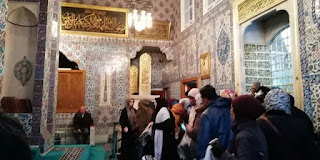Ephesus, The Ancient City
Ephesus adalah sebuah Ancient City, penuh dengan sejarah peninggalan zaman Greek. Ephesus terletuk di bandar Selcuk, kira-kira 30km sebelum sampai ke bandar Kusadasi.
The ancient Greek city of Ephesus was famous for its Temple of Artemis (The ancient Greek city of Ephesus was famous for its Temple of Artemis (near present-day Selçuk), which was recognized as one of the Seven Wonders of the Ancient World.
Ephesus; Ancient Greek city of Asia Minor, near the mouth of the Menderes River, in what is today West Turkey, South of Smyrna (now Izmir). One of the greatest of the Ionian cities, it became the leading seaport of the region. Its wealth was proverbial.
Ephesus, once, the trade centre of the ancient world, a religious centre of the early Christianity and today, Ephesus is an important tourism centre in Turkey. Ephesus in the UNESCO World Heritage List. The ancient city Ephesus is located in Selcuk, a small town 30km away from Kusadasi.
Ephesus(noun) an ancient Greek city on the western shore of Asia Minor in what is now Turkey; site of the Temple of Artemis; was a major trading center and played an important role in early Christianity.
Dekat Ephesus ni memang banyak sekali kucing
hmmm.. berkenan ke? heheee...
Ephesus was an ancient port city whose well-preserved ruins are in modern-day Turkey. The city was once considered the most important Greek city and the most important trading center in the Mediterranean region. Throughout history, Ephesus survived multiple attacks and changed hands many times between conquerors.
If you have the opportunity to visit then do - it's well worth traveling to. Ephesus is both fascinating and amazing and also quite beautiful. The site is very large and takes at least several hours to get around.
kat luar ada kedai aiskrim dan kedai souvenir...
melekat lah pulak.. isshhh isshhh..

































































